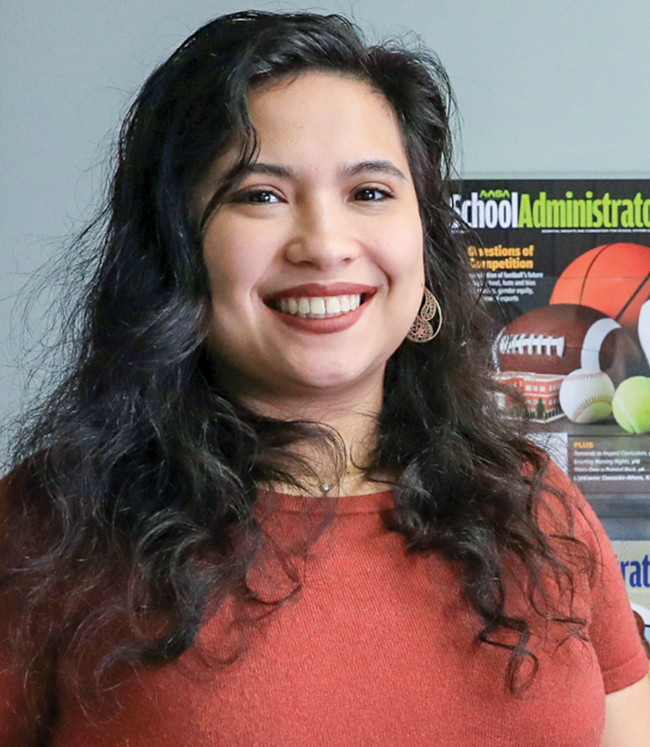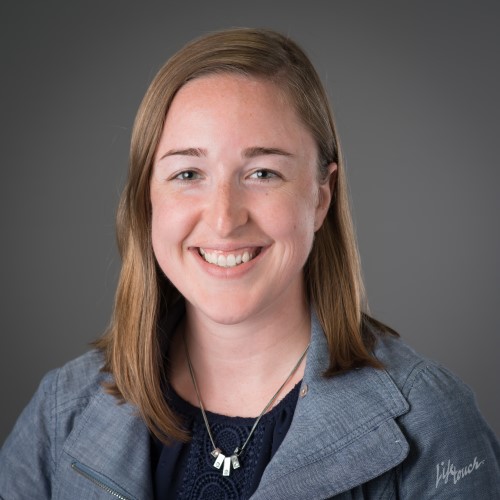Steering the Wheel of Our Editorial Processes
February 01, 2024
Appears in February 2024: School Administrator.
Inside AASA

By the time you’re reading this magazine, the publications staff at AASA already is busy working on another issue that will come out months from now. Jacqueline Hyman, the department’s senior editorial assistant, plays a crucial role in the time-sensitive process of publishing School Administrator each month, as well as AASA’s national conference newsletter, Conference Daily Online.
From producing the magazine’s table of contents and posting two digital issues online monthly to reviewing article submissions, overseeing the book reviewing process involving more than four dozen reviewers and handling back orders and article reprints, Hyman combines a background in journalism and education to help the award-winning magazine stay on its tight production schedule month after month. She contributes to keeping the publication one step ahead of the hotter K-12 education topics of interest for a national readership of superintendents and other administrative leaders.
Juli Valentine, who worked as AASA’s digital news editor and formerly occupied the magazine’s editorial assistant seat, recently interviewed Hyman. Her responses have been edited for clarity and length.
What is your primary role at AASA?
Hyman: My role as senior editorial assistant for School Administrator magazine basically means I do anything the magazine needs. During the National Conference on Education, I serve as the managing editor for Conference Daily Online, which is our daily e-newsletter that covers everything happening at the event.
How did you end up at AASA?
Hyman: Jay Goldman, who is the editor-in-chief of the publication, actually was a professor of mine in college and taught an editing class. I also have a background in education so this job kind of puts together my journalism and education backgrounds.
With a background in both, what prompted you to go into journalism instead of staying in the classroom?
Hyman: I really love journalism. I think it’s important. I think the power of telling stories and informing people is really critical. My teaching certification is in secondary English so it would be great if I could teach journalism, and I thought having experience in the field before that would be great for my future students.
What has been the biggest surprise for you when working with superintendents in this capacity after having been “on the other side” yourself?
Hyman: Having had the experience of being in the teacher’s seat, it’s been really interesting to see things from the perspective of the top leader in the district, which is just so different from the teacher’s perspective. It’s made me a little more understanding of things that you might get frustrated about as a teacher or of decisions that are made in the district because now I’ve witnessed a lot of just how difficult the job of being a superintendent is and how much goes into every decision. It’s a good eye-opener for understanding multiple levels of educator roles.
In an age where digital is king, to what do you attribute School Administrator’s popularity and survival as a monthly publication?
Hyman: I think what’s unique about the magazine is that it’s written specifically for our audience of superintendents and district leaders. We consider the many factors that go into their jobs when we plan each issue, and we arrange for experts in the field and superintendents or district employees to contribute to the magazine.
I think having that inside perspective to read about or to kind of open the reader’s mind from a place of common ground is really powerful for our members.
The fact our magazine is a membership benefit and not subscription-based helps because all of our members receive it. Through our readership studies, we are told they love the print magazine. They don’t want it to go fully digital. There is something nice about having a print product that people appreciate so that’s probably why it’s stood the test of time in print.
Our readers appreciate where the articles are coming from and the wide array of topics we cover. We try to stay really relevant to what’s happening in the world, but also give in-depth coverage on each topic.
What’s the process for researching articles for a particular theme of the magazine. How do you figure out what will go in each issue and how do you find authors?
Hyman: I usually start by going to my trusted news sources and reading about that topic from different sources to capture different angles. I figure out what is most relevant to our readers. From there, I reach out to experts on the subject and interview them just for background research to see whether they’re good potential authors or if they have suggestions of school districts to contact. I watch a lot of webinars on the topic and that can lend itself to finding good experts.
It’s a process of figuring out what’s related to the topic and how can that relate to our audience because even though these topics are always covered in other news publications, they’re not typically geared toward an audience of superintendents. So then it’s considering how can we make the angle relevant to our audience.
What has been your favorite magazine theme(s) to research and why?
Hyman: I’ve been lucky in getting assigned a lot of interesting topics. I did the March 2021 issue on racial equity, which I think did really well because we got a lot of interesting experts on that one. The one about protecting or supporting vulnerable students was interesting — I definitely learned a lot while researching that issue. We had somebody write about students experiencing homelessness and that was really interesting.
You are also the managing editor of Conference Daily Online. What’s it like to switch from having months to work on an issue of the magazine to more of a deadline-based news environment?
Hyman: I love it! I am used to deadline-based news because I was a reporter before I came here and that’s also mostly what I studied in school.
I really enjoy that fast pace and the rush of getting everything in and to a good state. Maybe to my detriment, I kind of thrive on deadlines. When there is more pressure, I can really focus and gear up, but it can be stressful.
Why do you think a daily newsletter accompanying the organization’s annual conference is so important?
Hyman: AASA’s conference is huge, and a lot of people don’t get to go to everything that they want to go to. I think our newsletter gives them the opportunity to learn what they missed, figure out what they’re interested in and, if they look at it daily, help them shift gears into what they want to look for the next day at the conference.
Also, I think it’s great to have a record of what’s going on at the conference after the fact because a lot of these presentations and roundtables are really great. And it’s helpful — as with any news, I guess — to be able to go back, read that and not lose the record of what was there.
What new and exciting things are up next for School Administrator?
Hyman: We have a lot of really timely topics planned this year in terms of what we’re covering: cybersecurity and data privacy, climate and sustainability, and personnel, which is really important with all the current shortages.
Inside AASA is an occasional column about principal employees and priorities of the association.
Author
Advertisement
Advertisement
Advertisement
Advertisement




